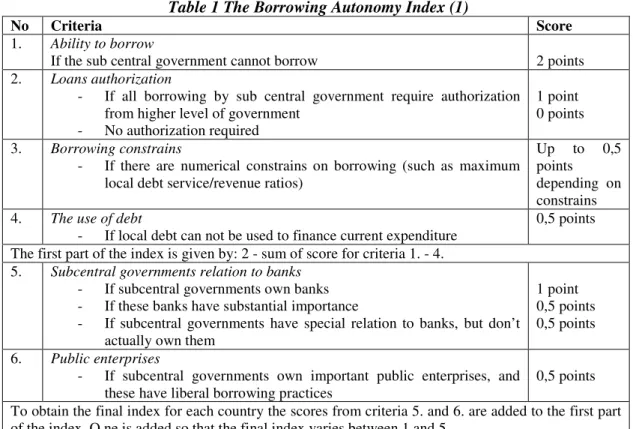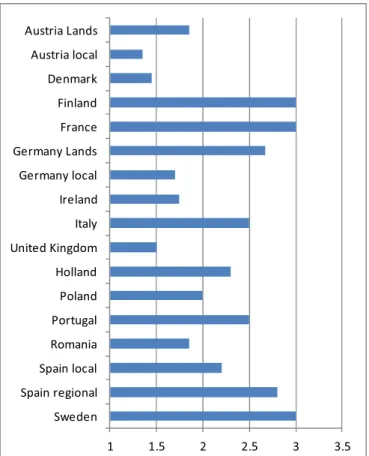LOCAL BORROWING AUTONOMY AS PART OF FISCAL DECENTRALIZATION PROCESS
Crâúneac O. Alexandru West University of Timiúoara,
Faculty of Economics and Business Administration
Beside the usual fiscal instruments like taxes and intergovernmental grants, sub-central governments have access to additional revenue through borrowing. When assessing the fiscal decentralization process, a key issue is the local borrowing autonomy, even though the fiscal decentralization literature has devoted surprisingly little attention to this topic. This paper examines the implications of sub-central government borrowing and the reasons behind the borrowing constrains they face. Based on the methodology developed by IADB, we have calculated a Borrowing Autonomy Index for Romania and compared the results to other countries providing a valuable insight on the fiscal decentralization specific features. Keywords: fiscal decentralization, sub-central government, local borrowing, borrowing autonomy. JEL codes: H71, H77
Introduction
In the setting of worldwide increase in the degree of fiscal decentralization and urbanization, local authorities are placed in a position to make important investments in areas such as infrastructure, water supply or transport. Thus, at the sub-national government level, the capital public expenditures tend to have a larger fraction of total expenditure, than for the higher levels of government. These public investments involve a high level of fiscal resources, which usually cannot be provided through current own revenues, being financed by capital transfers from central government. Unfortunately, when central governments are forced to implement measures to limit the budget deficit, public spending cuts usually operate among investments (Peterson, 1997). For this reason, local authorities are placed in a position to find alternative ways of financing investment projects, their access to capital markets becoming essential.
Besides the possibility to finance capital expenditure, local government loans can also serve to cover temporary cash flow deficits resulted from different timings in collecting receipts and making payments. Also, local authorities’ access to the financial resources supplied by the capital markets, under certain conditions, can promote a responsible behavior and may increase local officials’ accountability. Financial institutions may penalize, by increasing interest rates or refuse funding, local authorities with poor performance, and thus provides an independent mechanism for assessing the quality of local public policies (Ahmad, 2000).
For these reasons, institutions like the World Bank, EBRD, Inter-American Development Bank or Asian Development Bank are among the biggest supporters of increased autonomy regarding local public borrowing, as an essential component of financial decentralization.
taxes in future, but from the interest on loans will benefit, to a greater extent, citizens of other communities. To prevent this transfer of income from the community to other communities and also to limit the size of total public debt (as the local government debt is part of the public debt), most states have instituted various restrictions, limiting, in one form or another, local governments’ access to public loans. Ter-Minassian and Craig (1997) provide an extensive debate over the borrowing restrictions faced by sub central governments. They group these constrains into four categories: market discipline, co-operation, rules-based controls and administrative control by the central government.
Subnational governments borrowing autonomy
Local authorities’ permission to borrow on the capital market is an important step in the process of fiscal decentralization. Borrowing autonomy can enhance the efficiency effects and quality of governance associated with fiscal decentralization.
To assess the possibilities of public borrowing of local and regional governments, Inter-American Development Bank (1997) has developed a Borrowing Autonomy Index. It is built according to legislative requirements concerning the possibilities of local authorities borrowing and their relations with banks and state owned companies, as shown in Table no.1.
Table 1 The Borrowing Autonomy Index (1)
No Criteria Score
1. Ability to borrow
If the sub central government cannot borrow 2 points
2. Loans authorization
- If all borrowing by sub central government require authorization from higher level of government
- No authorization required
1 point 0 points
3. Borrowing constrains
- If there are numerical constrains on borrowing (such as maximum local debt service/revenue ratios)
Up to 0,5 points depending on constrains 4. The use of debt
- If local debt can not be used to finance current expenditure
0,5 points
The first part of the index is given by: 2 - sum of score for criteria 1. - 4. 5. Subcentral governments relation to banks
- If subcentral governments own banks - If these banks have substantial importance
- If subcentral governments have special relation to banks, but don’t actually own them
1 point 0,5 points 0,5 points
6. Public enterprises
- If subcentral governments own important public enterprises, and these have liberal borrowing practices
0,5 points
To obtain the final index for each country the scores from criteria 5. and 6. are added to the first part of the index. O ne is added so that the final index varies between 1 and 5.
Source: Inter-American Development Bank, "Fiscal Decision-making in Decentralized Democracies.", Latin America After a Decade of Reforms, Economic and Social Progress in Latin America Report, John Hopkins University Press, Washington D.C., 1997.
Based on the domestic legislation provisions we calculated the value of this index for Romania and for comparison with several EU Member States, we used the values calculated by Rodden (2002). The values of the index can range from 1 to 5, where 1 indicates no sub central government is able to borrow and 5 indicates full autonomy in borrowing, which is neither limited nor require any approval from central government. It can be argued that the values computed for the other countries refer to other periods of time and may induce a distorted image. However, the legislation regarding local borrowing powers changes rarely, especially in old Member States, that represent the bulk of the analysis.
Figure 1 The Borrowing Autonomy Index for selected EU Member States Source: Own calculations, Rodden (2002)
As shown in Figure 1, Most EU member states have restricted access to loans to local authorities, as the index recorded a maximum value of 3. These restrictions are a normal consequence of assuming the nominal convergence criteria stated in the Maastricht Treaty and subsequently enforced by the Stability and Growth Pact.
States where local authorities are required the fewest restrictions in accessing public loans are Sweden, France and Finland. In the federal states, generally, regional governments tend to have a greater freedom than local governments regarding access to loans. Regional governments in Spain are able to borrow even to cover temporary cash deficits by short-term loans, unlike Germany, where they can borrow only to finance medium and long term public investments. In Romania, local authorities may borrow only to finance investments or refinancing local debt. The legislative framework that enabled local authorities to access loans was developed by Law no 189/1998 regarding local government public finance. Under the current legislation, local authorities are not allowed access to loans or to guarantee any loan, if the total annual debt service from loans and/or guarantees is exceeding the limit of 30% of own revenue from taxes,
/ / /
fees, contributions and other payments, other revenue and also revenue sharing from income tax. Moreover, any local public loan must be approved by the Commission for local government debt authorization and local debt must be repaid exclusively from own revenue.
Conclusions
When analyzing the fiscal decentralization process, an important component is the local governments’ autonomy, which can be described by spending and tax autonomy, as well as by borrowing autonomy. To avoid excessive local public debt, all the EU Member States have imposed some restrictions for local governments in accessing loans. In the context of the current sovereign debt crisis, the control over sub-national borrowing becomes increasingly important. Romania, scoring 1,85 points on the Borrowing Autonomy Index granted local governments limited borrowing power, yet higher than some more developed countries such as Ireland, United Kingdom or Denmark. In the case of the EU Member States considered for our analysis we observe that between sub-national tax autonomy (Crâúneac, Heteú and Miru 2011) and borrowing autonomy is a strong connection observed among some Member States like France and Sweden. However, between the degree of decentralization, expressed by sub-national governments share in total public spending, and borrowing autonomy there is no direct relationship, some states with high degree of decentralization giving local authorities limited borrowing autonomy.
Notes
(1) The index was used by Anderson (2006) as part of a decentralization measure, but only the first part of the index, the values ranging from 0 to 2.
Acknowledgement
This work was supported by the project "Post-Doctoral Studies in Economics: training program for elite researchers - SPODE" co-funded from the European Social Fund through the Development of Human Resources Operational Programme 2007-2013, contract no. POSDRU/89/1.5/S/61755
References
1. Ahmad, J.. „Decentralizing Borrowing Powers”, Decentralization Briefing Notes, ed. Litvack, Jennie, Seddon, Jessica, World Bank Institute Working Papers, 2000.
2. Anderson, C.D., Economic Voting and Multilevel Governance: A Comparative Individual-Level Analysis, American Journal of Political Science, Volume 50, Issue 2, 2006, pages 449– 463.
3. Crâúneac, A., Heteú, Roxana, Miru, Oana. “Fiscal decentralization and fiscal autonomy in the EU Member States”, The annals of the University of Oradea. Economic science, no. 1, 2011, pp. 370-375.
4. Oates, W.E.. “The Theory of Public Finance in a Federal System”, Canadian Journal of Economics, no 1, 1968.
5. Peterson, G.. “Building Local Credit Systems.”, Urban Management Program Policy Paper, World Bank, Washington D.C., 1997.
6. Rodden, J.. “The Dilemma of Fiscal Federalism: Grants and Fiscal Performance Around the World”, American Journal of Political Science, no. 46, pp. 670-687, 2002.
*** Inter-American Development Bank. "Fiscal Decision-making in Decentralized Democracies.", Latin America After a Decade of Reforms, Economic and Social Progress in Latin America Report, John Hopkins University Press, Washington D.C., 1997.

